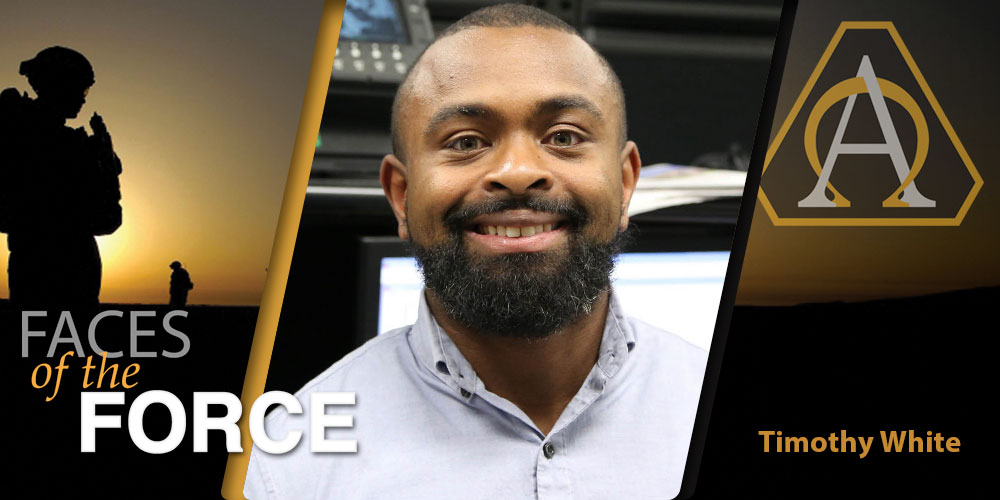
COMMAND/ORGANIZATION: Software Engineering Directorate, U.S. Army Aviation and Missile Research, Development and Engineering Center
POSITION AND OFFICIAL TITLE: Computer engineer
YEARS OF SERVICE IN WORKFORCE: 7
DAWIA CERTIFICATIONS: Level III in engineering
EDUCATION: M.S. in engineering with a concentration in systems engineering, University of Alabama in Huntsville; B.S. in computer engineering, Jackson State University
AWARDS: Software Engineering Directorate’s Above and Beyond the Call of Duty Award
Maximizing the advantages of a STEM education
By Susan L. Follett
“Changing the world, one line of code at a time.” That’s one way that Timothy White, a computer engineer, thinks of the work he does for the Software Engineering Directorate (SED) within the U.S. Army Aviation and Missile Research, Development and Engineering Center (AMRDEC).
White works on the Tactical Airspace Integration System (TAIS), which provides air-ground synchronization, planning and airspace integration to support mission command. That project is part of the Product Manager for Air Traffic Control (ATC), part of the Project Management Office for Aviation Systems within the Program Management Office for Aviation.
Having a front-row seat to developing a project that helps warfighters carry out their missions is just one benefit White sees from getting an education in a science, technology, engineering and math (STEM) field. “Almost every industry can benefit from the skills and knowledge that someone obtains from a technical background in a STEM-related field,” he noted.
Briefly describe what you do in your position and why it’s important to the Army or the warfighter.
I am the software lead on a project that provides tactical data link monitoring and processing for Product Manager ATC’s TAIS, which provides situational awareness of friendly and enemy air activity and is interoperable with joint, coalition and civil aviation forces. One great benefit of being an Army Acquisition Workforce employee and working on this project is the fact that the software that my team designs, develops, integrates and tests helps warfighters carry out their mission.
What’s the biggest challenge you face in your work?
One of the biggest challenges we face is producing the best product for our customers in a fiscally conservative environment. We aim to provide the best capabilities for the warfighter, and in the current environment there are ever-changing budgetary constraints that ultimately affect requirements and our schedule. However, we’re working to ensure that we’re able to deliver products to aid the warfighter.
How did you become part of the Army Acquisition Workforce, and why?
I began my career with the Army Acquisition Workforce initially as a co-op student at AMRDEC’s SED. From this opportunity, I was able to see the amazing things that were being done here in support of the warfighter. When I was offered a full-time position, I eagerly accepted.
What do you see as the most important points in your career with the Army Acquisition Workforce, and why?
For me, the most important point in my career was realizing early on that I have the flexibility to explore different options in software development here at SED while also doing fulfilling work that aids the warfighter. Just by walking down the hall, you can see the wide range of programs that are supported and that’s just within this building. There are numerous other opportunities at AMRDEC.
One of them is the Daedalus Program, an outside-the-box thinking group that allowed me the opportunity to work with great engineers throughout the center as well as research different ways to repurpose the wide range of Army products, systems and capabilities. I was a part of a Daedalus team comprising junior- to mid-level engineers throughout AMRDEC, and our topic was “Teaching Old Dogs New Tricks,” defining new ways to use existing aviation weapon technology. This topic was provided in the context of a complex, real-world scenario where the team researched ways to repurpose existing Army aviation assets. The team had the opportunity to learn from numerous subject matter experts, aiding in knowledge transfer across the organization, and it gave us the chance to “deep dive” pragmatic solutions outside of the normal structure of the work environment.
Can you name a particular mentor or mentors who helped you in your career? How did they help you?
Having the opportunity to be mentored by senior engineers in the organization is one of the best benefits of my job. One of the most significant mentors I have is Bryan Kubishta, a senior computer engineer with SED. He has guided me in my early years as a junior developer in the Army Acquisition Workforce. One of his favorite quotes is, “Changing the world, one line of code at a time.” Thanks to his mentoring, I’ve made sure that I maintain my technical prowess as I progress throughout my career.
What advice would you give to someone who aspires to a career similar to yours?
Since I am still on the early side of my career, my advice to younger individuals would be pick a major in the STEM field and stick with it. There will be challenging classes, labs and many late nights; however, it will all be worth it because of what you’ll learn.
“Faces of the Force” is an online series highlighting members of the Army Acquisition Workforce through the power of individual stories. Profiles are produced by the U.S. Army Acquisition Support Center Communication and Support Branch, working closely with public affairs officers to feature Soldiers and civilians serving in various AL&T disciplines. For more information, or to nominate someone, please contact 703-664-5635.
Subscribe to Army AL&T News, the premier online news source for the Acquisition, Logistics, and Technology (AL&T) Workforce.







